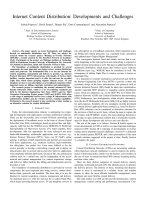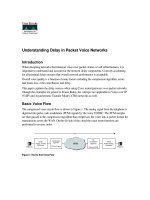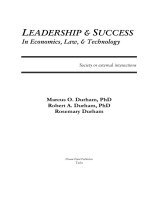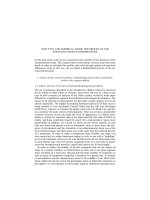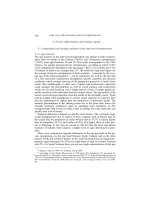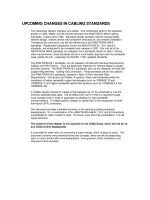Tài liệu Emotion Regulation in Couples and Families ppt
Bạn đang xem bản rút gọn của tài liệu. Xem và tải ngay bản đầy đủ của tài liệu tại đây (18.96 MB, 327 trang )
Emotion
Regulation
in
Couples
and
Families
Pathways
to
Dysfunction
and
Health
EDITED
BY
Douglas
K.
Snyder,
Jeffry
A.
Simpson,
and Jan N.
Hughes
AMERICAN
PSYCHOLOGICAL
ASSOCIATION
Washington,
DC
Copyright
©
2006
by the
American Psychological Association.
All
rights reserved. Except
as
permitted under
the
United States Copyright
Act of
1976,
no
part
of
this publication
may
be
reproduced
or
distributed
in any
form
or by any
means, including,
but not
limited
to, the
process
of
scanning
and
digitization,
or
stored
in a
database
or
retrieval system,
without
the
prior written permission
of the
publisher.
Published
by
American Psychological Association
750
First
Street,
NE
Washington,
DC
20002
www.apa.org
To
order
APA
Order Department
P.O.
Box
92984
Washington,
DC
20090-2984
Tel: (800) 374-2721; Direct: (202) 336-5510
Fax:
(202) 336-5502;
TDD/TTY:
(202) 336-6123
Online:
www.apa.org/books/
E-mail:
In the
U.K., Europe,
Africa,
and the
Middle East, copies
may be
ordered
from
American Psychological Association
3
Henrietta Street
Covent
Garden, London
WC2E
8LU
England
Typeset
in
Goudy
by
Stephen McDougal, Mechanicsville,
MD
Printer: United Book Press, Inc., Baltimore,
MD
Cover
Designer: Minker Design, Bethesda,
MD
Technical/Production Editor: Genevieve Gill
The
opinions
and
statements published
are the
responsibility
of the
authors,
and
such
opinions
and
statements
do not
necessarily represent
the
policies
of the
American
Psychological
Association.
Library
of
Congress
Cataloging-in-Publication
Data
Emotion regulation
in
couples
and
families
:
pathways
to
dysfunction
and
health
/
edited
by
Douglas
K.
Snyder,
Jeffry
A.
Simpson,
Jan N.
Hughes.—
1st ed.
p. cm.
Includes bibliographical references
and
indexes.
ISBN 1-59147-394-2
1.
Emotions.
2.
Emotions—Social aspects.
3.
Interpersonal relations.
I.
Snyder, Douglas
K.
II.
Simpson,
Jeffry
A.
III. Hughes,
Jan N.,
1949-
BF531.E4955 2006
152.4—dc22 2005031777
British
Library
Cataloguing-in-Publication
Data
A CIP
record
is
available
from
the
British
Library.
Printed
in the
United States
of
America
First Edition
To my
wife,
Linda,
and to
Christopher, Eric, Natalie,
and
Jason,
for
your love
and
support.
—Douglas
K.
Snyder
To
Cindy, Chris,
and
Natalie,
for
your support
and
the
many good times
that
we
have shared.
—Jeffry
A.
Simpson
To
Mrs. Harding,
my
kindergarten teacher,
for a
good start.
—Jan
N.
Hughes
CONTENTS
About
the
Editors
xi
Contributors
xiii
Introduction: Cross-Disciplinary Approaches
to
Emotion Regulation
3
Jeffry
A.
Simpson,
Jan N.
Hughes,
and
Douglas
K.
Snyder
I.
Emotion Regulation:
Theoretical
Perspectives
11
Chapter
1.
Emotion Regulation
in
Everyday
Life
13
James
J.
Gross, Jane
M.
Richards,
and
Oliver
P.
John
Chapter
2.
Emotional Intelligence
and the
Self-Regulation
of
Affect
37
Dais;y
Grewal, Marc
Brackett,
and
Peter
Salovey
Chapter
3.
Adult Attachment Theory
and
Affective
Reactivity
and
Regulation
57
Paula
R.
Pietromonaco,
Lisa
Feldman
Barrett,
and
Sally
I.
Powers
II.
Linking Emotion Regulation
to
Dysfunction
and
Weil-Being
Across
the
Life
Span
75
Chapter
4.
Attachment
Bases
of
Emotion Regulation
and
Posttraumatic
Adjustment
77
Mario
MilcuJincer,
Phillip
R.
Shaver,
and
Neta
Horesh
Chapter
5.
Happy Victimization: Emotion Dysregulation
in the
Context
of
Instrumental, Proactive
Aggression
101
William
F.
Arsenio
Chapter
6.
Parenting
and
Children's Adjustment:
The
Role
of
Children's Emotion Regulation
123
Garbs
Valiente
and
Nancy
Eisenberg
Chapter
7.
Family
and
Peer Relationships:
The
Role
of
Emotion Regulatory Processes
143
Ross
D.
Parke, David]. McDowell, Mina Cladis,
and
Melinda
S.
Leidy
Chapter
8.
Marital Discord
and
Children's Emotional
Self-Regulation
163
E.
Mark Cummings
and
Peggy
S.
Keller
Chapter
9.
Individual
Differences
in
Emotion Regulation
and
Their Relation
to
Risk Taking During
Adolescence
183
M.
Lynne Cooper,
Mindy
E.
Flanagan,
Amelia
E.
Talley,
and
Lada Micheas
III.
Clinical
Interventions
in
Emotion
Regulation
Processes
. . . 205
Chapter
10.
Emotion Regulation Processes
in
Disease-
Related Pain:
A
Couples-Based Perspective
. . . 207
Francis].
Keefe,
Laura
S.
Porter,
and
Jeffrey
Labban
Chapter
11.
Promoting Emotional Expression
and
Emotion
Regulation
in
Couples
231
Rhonda
N.
Goldman
and
Leslie
S.
Greenberg
Chapter
12.
Intervening
With
Couples
and
Families
to
Treat
Emotion Dysregulation
and
Psychopathology
249
Alan
E.
Fruzzetti
and
Katherine
M.
Iverson
Chapter
13. Who
Took
My Hot
Sauce? Regulating
Emotion
in the
Context
of
Family Routines
and
Rituals
269
Barbara
H.
Fiese
CONTENTS
IV.
Integration
291
Chapter
14.
Family Emotion Regulation Processes:
Implications
for
Research
and
Intervention
. . . 293
Douglas
K.
Snyder,
Jan N.
Hughes,
and
]effry
A.
Simpson
Author Index
307
Subject
Index
319
CONTENTS
ix
ABOUT
THE
EDITORS
Douglas
K.
Snyder,
PhD,
is a
professor
and the
director
of
clinical psychol-
ogy
training
at
Texas
A&M
University.
He
received
the
American Psycho-
logical
Association's
2005
award
for
Distinguished
Contributions
to
Family
Psychology
for
his
work
on
empirical approaches
to
assessment
and
interven-
tions with distressed couples.
He is the
author
of the
widely used Marital
Satis/action Inventory
and is
coeditor
of
Treating
Difficult
Couples.
He
received
the
American Association
for
Marriage
and
Family Therapy's 1992 Outstand-
ing
Research Award
for his
4-year follow-up study comparing behavioral
and
insight-oriented
approaches
to
couple
therapy, funded
by the
National
Insti-
tute
of
Mental
Health.
Dr.
Snyder
is a
fellow
of the
American Psychological
Association
and has
served
as
associate editor
for the
journal
of
Consulting
and
Clinical
Psychology
and the
Journal
of
Family
Psychology.
Jeffry
A.
Simpson,
PhD,
is a
professor
of
psychology
at the
University
of
Minnesota,
Twin
Cities
Campus.
His
primary
research
interests
center
on
adult attachment processes, models
of
human mating, idealization processes
in
relationships,
the
management
of
empathic accuracy
in
relationships,
and
social influence strategies.
He is a
fellow
of the
American Psychological
Association
and the
American Psychological
Society.
From 1998
to
2001,
he
served
as
editor
of the
journal Personal
Relationships
and
currently serves
as
an
associate editor
for the
Journal
of
Personality
and
Social
Psychology:
Interpersonal
Relations
and
Group Processes.
In
addition,
he has
served
on
grant
panels
at the
National
Science
Foundation
and the
National Insti-
tute
of
Mental
Health.
His
various programs
of
research
on
close relation-
ships
have been
funded
by
grants
from
the
National
Science
Foundation,
the
National Institute
of
Mental Health,
and the
Marsden Foundation
in New
Zealand.
Jan
N.
Hughes,
PhD,
is a
professor
of
educational
psychology
at
Texas
A&M
University.
She is a
distinguished research
fellow
in the
College
of
Educa-
tion
and
Human Development,
and her
primary
research interests center
on
the
development
and
treatment
of
childhood
aggression,
teacher-student
relationships
as
developmental resources,
the
development
of
social
and
emotional
competencies,
and
peer relationships.
The
National Institute
of
Child
Health
and
Human Development,
the
National Institute
on
Drug
Abuse,
and the
U.S. Department
of
Education have
funded
her
research.
She
serves
on the
editorial boards
of the
Journal
of
Clinical Child
and
Adoles'
cent
Psychology
and the
Journal
of
School
Psychology.
A
fellow
of the
American
Psychological
Association,
she has
served
in
numerous leadership roles
in-
eluding president
of the
division
of
School
Psychology.
xii
ABOUT
THE
EDITORS
CONTRIBUTORS
William
F.
Arsenic,
PhD, Ferkauf Graduate School
of
Psychology,
Yeshiva University,
New
York
Lisa Feldman Barrett, PhD, Department
of
Psychology, Boston College,
Boston,
MA
Marc
Brackett,
PhD, Department
of
Psychology,
Yale
University,
New
Haven,
CT
Mina
Cladis,
PhD, Department
of
Psychology, Vassar
College,
Poughkeepsie,
NY
M.
Lynne
Cooper,
PhD, Department
of
Psychological Sciences,
University
of
Missouri, Columbia
E.
Mark Cummings, PhD, Department
of
Psychology, University
of
Notre
Dame,
IN
Nancy Eisenberg, PhD, Department
of
Psychology,
Arizona State
University,
Tempe
Barbara
H.
Fiese, PhD, Department
of
Psychology, Syracuse University,
Syracuse,
NY
Mindy
E.
Flanagan, PhD, Roudebush Veterans Administration Medical
Center, Indianapolis,
IN
Alan
E.
Fruzzetti,
PhD, Department
of
Psychology, University
of
Nevada,
Reno
Rhonda
N.
Goldman, PhD, School
of
Professional
Psychology, Argosy
University,
Schaumburg,
IL; The
Family Institute
at
Northwestern
University,
Chicago,
IL
Leslie
S.
Greenberg, PhD, Department
of
Psychology, York University,
Toronto, Ontario, Canada
Daisy
Grewal,
MS,
Department
of
Psychology, Yale University,
New
Haven,
CT
James
J.
Gross,
PhD, Department
of
Psychology, Stanford University,
Stanford,
CA
xm
Neta
Horesh,
PhD, Department
of
Psychology, Bar-Han University,
Ramat-Gan, Israel
Jan
N.
Hughes,
PhD, Department
of
Educational Psychology, Texas
A&M
University, College Station
Katherine
M.
Iverson,
MA,
Department
of
Psychology, University
of
Nevada, Reno
Oliver
P.
John,
PhD, Department
of
Psychology, University
of
California,
Berkeley
Francis
J.
Keefe, PhD, Department
of
Psychiatry
and
Behavioral Sciences
and
Psychology:
Social
and
Health
Sciences, Duke University
Medical
Center
and
Duke University, Durham,
NC
Peggy
S.
Keller,
MA,
Department
of
Psychology, University
of
Notre
Dame, Notre Dame,
IN
Jeffrey
Labban,
BA,
Department
of
Psychiatry
and
Behavioral Sciences,
Duke
University Medical Center, Durham,
NC
Melinda
S.
Leidy,
MA,
Department
of
Psychology, University
of
California, Riverside
David
J.
McDowell,
PhD, Department
of
Clinical
and
Social Psychology,
University
of
Rochester, Rochester,
NY
Lada
Micheas,
MS,
Department
of
Psychological Sciences, University
of
Missouri,
Columbia
Mario Mikulincer, PhD, Department
of
Psychology,
Bar-Han
University,
Ramat-Gan, Israel
Ross
D.
Parke,
PhD, Department
of
Psychology, University
of
California,
Riverside
Paula
R.
Pietromonaco,
PhD, Department
of
Psychology, University
of
Massachusetts, Amherst
Laura
S.
Porter,
PhD, Department
of
Psychiatry
and
Behavioral Sciences,
Duke University Medical Center, Durham,
NC
Sally
I.
Powers,
EdD, Department
of
Psychology, University
of
Massachusetts, Amherst
Jane
M.
Richards,
PhD, Department
of
Psychology, University
of
Texas,
Austin
Peter
Salovey,
PhD, Department
of
Psychology, Yale University,
New
Haven,
CT
Phillip
R.
Shaver,
PhD, Department
of
Psychology, University
of
California,
Davis
Jeffry
A.
Simpson, PhD, Department
of
Psychology, University
of
Minnesota, Minneapolis
Douglas
K.
Snyder, PhD, Department
of
Psychology, Texas
A&M
University,
College
Station
Amelia
E.
Talley,
MA,
Department
of
Psychological Sciences, University
of
Missouri, Columbia
Carlos
Valiente,
PhD, Department
of
Family
and
Human Development,
Arizona
State
University, Tempe
CONTRIBUTORS
Emotion
Regulation
in
Couples
and
Families
INTRODUCTION:
CROSS-DISCIPLINARY
APPROACHES
TO
EMOTION REGULATION
JEFFRY
A.
SIMPSON,
JAN N.
HUGHES,
AND
DOUGLAS
K.
SNYDER
In
recent years, there
has
been growing interest
in
emotion regulation
processes
within
different
areas
of
psychology.
This
interest
has
been sparked
both
by the
development
of new
theoretical models
of
emotion regulation
processes
and by the
growing realization
that
poor
or
inappropriate regula-
tion
of
emotions
often
constitutes
a
core
component
of
common
individual
and
interpersonal problems. Indeed,
the
ability
to
effectively
control
and
manage emotions during social interactions—especially interpersonally caus-
tic
negative emotions—may assume
a
pivotal role
in
keeping individuals
and
their significant relationships happy
and
functioning well.
New
theoretical
approaches
to
understanding
emotion
regulation (e.g.,
chaps.
2 and 3,
this
volume)
and new
process models outlining exactly
how
emotions might
be
regulated
(e.g., chap.
1,
this volume) have begun
to
illuminate when, how,
and why
people succeed
or
fail
to
regulate certain emotions
in
social con-
texts.
This
theoretical work
is
also beginning
to
identify
some
of the
impor-
tant
processes,
both
intrapersonal
and
interpersonal,
that
may be
associated
with
successful
versus unsuccessful emotion regulation.
For
example, more
emotionally intelligent individuals,
who are
particularly skilled
at
control-
ling
and
managing negative emotions, tend
to be
better adjusted
on
many
different
dimensions
than
those
who are
less emotionally intelligent.
In ad-
dition,
more emotionally intelligent, well-regulated people
are
often more
likely
to be
involved
in
happier
and
better-functioning relationships, includ-
ing
romantic
and
family-based
ones.
3
From
an
applied standpoint,
a
deeper understanding
of how
emotion
regulation processes operate
in
both
community
and
clinical populations could
eventually
help practitioners
to
more
effectively
treat
a
wide range
of
inter-
personal problems
and
disorders, many
of
which
may
originate,
at
least
in
part,
from
poor
or
deficient emotion regulation.
As
several chapters
in
this
volume highlight, delineating
how
various emotion regulation processes
and
psychological
mechanisms
vary across community
and
clinical
populations
may
shed important light
on
some
of the
conditions
that
initiate, sustain,
or
potentially ameliorate several comorbid interpersonal disorders.
When
we
convened
the
Texas
A&M
University Conference
on
Emo-
tion Regulation
in
Couples
and
Families
in
February 2004,
on
which this
volume
is
based,
our
overarching goal
was to
bring together some
of the top
international scholars
who
were conducting important, cutting-edge research
on
emotion regulation
in
different
fields
of
psychology.
We
anticipated
that
these
individuals would
(a)
openly propose
and
discuss
how the
construct
of
emotion
regulation should
be
optimally conceptualized, defined,
and
mea-
sured;
(b)
share
and
critique
the
major
theories, ideas,
and
knowledge
on im-
portant emotion regulation processes
and
outcomes
in
their respective
fields;
and (c)
begin
to
develop some cross-disciplinary theories, models, hypotheses,
or new
ways
of
thinking about emotion regulation that would
facilitate
cross-
disciplinary work among
different
fields
in
psychology
(e.g.,
clinical, develop-
mental, educational,
family
studies, social-personality,
and
quantitative-
methodological). This book
is the
legacy
of
that
successful
conference.
The
inability
to
regulate
emotions
can
increase
an
individual's risk
for
problems
in
many social, interpersonal, academic, work-related,
and
health
domains.
This
book covers
a
wide range
of
important theoretical, concep-
tual,
and
methodological
issues
that
are
critical
to
understanding
both
nor-
mal and
adaptive emotion regulation processes
as
well
as
more dysfunctional
ones.
In
particular,
the
chapters
in the
book present empirical
findings
rel-
evant
to
emotion regulation processes
both
within
and
between individuals
involved
in
different
types
of
relationships across
the
life
span.
The
chapters
also
contain
myriad insights
and
implications
for
clinical intervention, pub-
lic
policy,
and
directions
for
future
research. Because
the
chapter contribu-
tors hail
from
different
academic disciplines
and
have diverse theoretical
perspectives regarding
the
role
that
emotion
regulation processes might play
in
both
healthy
and
dysfunctional outcomes,
the
book should
be
relevant
to
a
broad range
of
people
who
share
an
interest
in
emotion regulation, includ-
ing
clinical
and
counseling psychologists, developmental psychologists,
so-
cial
and
personality psychologists,
and
communication
and
family
studies
scholars,
to
name
a
few.
In
addition
to
focusing
on
recent research
findings,
the
book also
highlights
therapeutic
and
public policy issues.
Thus,
it
should
also
be
quite
useful
to
practitioners
who are
working with children, adoles-
cents, adults, couples,
and
families,
especially those
who
struggle with emo-
tion
regulation
difficulties.
4
SIMPSON,
HUGHES,
AND
SNYDER
CONCEPTUAL
AND
THEORETICAL ISSUES
Because
intense research interest
in
emotion regulation
is a
recent phe-
nomenon
and
emotion regulation
has
broad relevance
to
many domains
of
human functioning across
the
life
span (including emotional
and
physical
health,
learning, work,
and
social relationships),
it is not
surprising
that
a
consensus definition
of
emotion
regulation
has not yet
emerged. Whereas
some
researchers decry
the
lack
of
theoretical consensus
and
operational
defi-
nitions (Cole, Martin,
&
Dennis, 2004),
at
this point
in the
development
of
the
science
of
emotion regulation,
a
degree
of
pluralism
in
theoretical
conceptualizations,
definitions,
and
measures prevents
the
premature nar-
rowing
of
research
foci
and
methods.
The
authors
in
this volume agree
on
much concerning
the
construct
of
emotion
regulation
yet
also
differ
in
important
ways.
Whether
explicitly
or
implicitly,
they agree
that
the
construct
of
emotion regulation includes con-
scious
and
unconscious, voluntary
and
less-than-voluntary, physiological,
behavioral,
and
cognitive processes that permit individuals
to
"influence
which emotions they have, when they have them,
and how
these emotions
are
experienced
and
expressed" (chap.
1, p.
14). Furthermore,
emotion
regu-
lation
is
viewed
as
functionally adaptive
in
that
it
facilitates attainment
of
one's goals.
As a
corollary, emotion regulation, which
is
adaptive,
is
distin-
guished
from
emotion control, which
can be
adaptive (e.g., when
suppress-
ing a
display
of
anger toward one's boss)
or
maladaptive
(e.g.,
in the
case
of
an
inhibited
boy who
suppresses
his
expression
of
both
positive
and
negative
emotions, resulting
in
poor peer relationships
and
restricted exploration
of
his
environment).
In
addition, regulation
can
involve
the
initiation, main-
tenance,
and
expression
of
positive emotions
as
well
as the
avoidance, mini-
mization,
and
masking
of
negative ones. Generally,
the
authors accept Gross
and
colleagues'
distinction
in
chapter
1
between antecedent-focused emo-
tion regulation, which involves regulatory processes that precede
and
antici-
pate
an
emotional reaction,
and
response-focused regulation, which occurs
in
response
to an
activated emotion.
The
authors also concur
that
emotion
regulation
is
only
one
aspect
of "an
interrelated
family
or
cluster
of
abilities
that
work
together"
(chap.
7, p.
145)
to
achieve interpersonal
and
intraper-
sonal goals.
Despite these areas
of
general consensus,
the
authors' conceptualizations
of
emotion regulation diverge explicitly
or
implicitly
in
important
ways
that
reflect
points
of
disagreement
discussed
in
recent literature (e.g.,
Bridges,
Denham,
&
Ganiban, 2004; Campos, Frankel,
&
Camras, 2004;
Cole
et al,
2004).
For
example,
how
much "voluntariness" over some activity
is
required
for
it to be
considered emotion regulation? Grewal, Brackett,
and
Salovey's
definition
of
emotion regulation (chap.
2)
emphasizes conscious
and
volun-
tary
aspects
(i.e.,
"the ability
to
monitor
and
label one's
own
feelings
effec-
tively
and
self-efficacy
about
the
ability
to
modify
these
feelings,
as
well
as
INTRODUCTION
5
the
knowledge
and
motivation
to use
effective
strategies
to
alter emotions,"
p.
41). Mikulincer,
Shaver,
and
Horesh (chap.
4),
however, view
emotion
regulation
as an
aspect
of an
individual's attachment system
that
operates
predominantly outside
of
conscious awareness
and
influences individuals' emo-
tional reactions
to
threats
to
their security. Valiente
and
Eisenberg (chap.
6)
engage
the
"voluntariness" issue
head
on,
distinguishing between reactive
control,
which
is
considered
an
aspect
of
temperament evident
in
early
in-
fancy,
and
effortful
control,
which
is
more voluntary, emerges toward
the
end of the
first
year
of
life,
is
more influenced
by
socialization experiences,
and
becomes increasingly important with
age in
contributing
to
individual
differences
in
coping with emotions.
In
addition,
the
authors also
differ
in
their relative
focus
on
discrete
emotional, cognitive,
or
physiological responses
to
emotionally arousing
situ-
ations
versus
organized patterns
of
responding.
The
field
appears
to be
mov-
ing
more
to
configurations
of
emotion expression
and
regulation (see chaps.
8 and
13).
As the
field
moves
in
this direction,
it
will
be
important
to
differ-
entiate
between processes associated with
the
initial arousal
of
emotions (e.g.,
individual
differences
in
general emotional reactivity)
and
those
associated
with
emotion regulation processes
per se
(see chap.
1). To
date,
insufficient
attention
has
been
focused
on
questions
of
whether
or how
emotion regula-
tion processes might
be
influenced
by
stable individual
differences
in the
tendency
to
initially
experience stronger
versus
weaker emotional reactions
in
response
to
specific
stimuli.
Effective
emotion regulation may,
for
instance,
be
more
difficult
to
achieve
for
individuals
who
habitually experience strong
emotional reactions
to
certain
stimuli
or
events.
Given
the
lack
of
consistency
in
operational definitions
of
emotion
regulation,
it is
important
that
researchers clearly link their measurements
of
emotion regulation
to
theoretical conceptualizations,
a
goal
that
is met to
varying
degrees
by the
authors
in
this volume.
For
example, Valiente
and
Eisenberg
(chap.
6)
achieve this when they distinguish between
two
aspects
of
emotion regulation
that
differ
in
voluntariness. Cummings
and
Keller
(chap.
8)
accomplish this
by
studying emotion regulation
in one
context
(marital
conflict)
and
interpreting their findings within
the
broader
frame-
work
of the
emotional security hypothesis, which
has
strong empirical
and
theoretical support. Gross
and his
colleagues (chap.
1)
classify
emotion regu-
lation strategies
in
terms
of
when they have their primary impact
on the
emotion-generation process. Adopting
an
attachment
framework,
Pietromonaco
and her
colleagues (chap.
3)
distinguish between
two
affect-
based
processes
that
underlie working models
of
attachment:
affect
reactivity
and
affect
regulation.
The
emotion regulation area
will
benefit
from
continued
efforts
to de-
fine
and
operationalize
key
constructs.
For
example, when does
another
person's attempt
to
modify
an
individual's emotions constitute emotion regu-
lation?
Do
strategies initiated
by or
perhaps imposed
on
another individual
6
SIMPSON, HUGHES,
AND
SNYDER
constitute emotion regulation, such
as a
parent reminding
her
daughter
that
her
unkind remark
to
another child resulted
in the
other
child feeling
sad
(an
example
of an
intrapersonal
attempt
to
up-regulate empathy)? Does
the
common inference
of
"poor emotion regulation" when individuals display
problematic
or
disruptive behavior overextend
the
construct, limiting
its
use-
fulness?
Rejecting
this
concern,
Cooper,
Flanagan, Talley,
and
Micheas
(chap.
9)
assert
that
adolescent risk-taking behavior (e.g., alcohol abuse
and
aspects
of
sexual behavior) reflects
an
effort
to
regulate
the
quality
of
both positive
and
negative emotional experience.
In a
similar way, Arsenio (chap.
5)
pro-
poses
a
phenomenon
of
"happy victimization"
as an
indicator
of
poor emo-
tion
regulation, arguing
that
such victimizing behavior reflects either
a
fail-
ure
to
experience empathy
that
inhibits aggression
or a
moral
or
emotional
deficit.
By
bringing together
in one
volume scholars
from
diverse
fields,
one
gains
an
appreciation
of the
wide range
of
conceptualizations, definitions,
and
measures
of
emotion regulation that exist across
different
contexts, ages,
and
purposes, ranging from understanding
the
origins
of
individual
differ-
ences
in
emotion regulation
to
teaching
one
member
of a
couple
how to
relieve
chronic
pain experienced
by his or her
partner.
We
hope
that
the
opportunity
this
volume provides
to
understand
how
different disciplines
are
approaching common
issues
in
emotion regulation will lead
to
refined
conceptualizations
and
measures
that
will
be
valuable both
from
scientific
and
clinical perspectives.
EMOTION
REGULATION
IN THE
CONTEXT
OF
FAMILIES
AND
CLOSE
RELATIONSHIPS
Attention
to the
role
of
parenting
in the
socialization
of
children's
emotional competencies
has a
long history
in
child development.
The au-
thors
in
this volume contribute
to
this rich tradition
by
delineating
how
both
specific
parenting practices (see chaps.
6 and 7) and
repetitive patterns
of
family
interaction (chaps.
8 and 13) are
associated with children's abilities
to
manage
their
emotions.
Scholars
from
diverse backgrounds
present
con-
verging
evidence that secure mental representations
of
parent-child
and
fam-
ily
interactions
may be
responsible
for
some
of the
connections between
family
interactions
and
children's
emotion
regulation.
The
authors
in
this
volume
also "raise
the
bar"
for
research
on how
parenting socialization
affects
emo-
tions,
from
studies demonstrating bivariate associations among various
parenting
behaviors
and
children's
emotion-related skills
to
longitudinal stud-
ies
testing causal pathways. Such designs
are
contributing greatly
to our
knowl-
edge
and
understanding
of how
children's emotion regulatory
skills
and
abili-
ties
both mediate
and
moderate
the
effects
of
parenting
on
children's social
competence.
These
studies also permit
the
testing
of
bidirectional causal path-
INTRODUCTION
7
ways
between child
and
parent behaviors. Moreover, several research
find-
ings
reported
in
these chapters highlight
the
fact
that
parenting
and
emotion
regulation occur within
a
cultural context,
and
that
links between parent
emotion-related socialization behaviors
and
children's social competencies
often
differ
across
cultures.
Chapters
in
this volume also address
the
importance
of
emotion
regula-
tion
in
close relationships.
As
several chapters highlight, poor
or
inadequate
emotion regulation
at the
intrapersonal level (i.e., within individuals)
or the
interpersonal level (i.e., between relationship partners) might
be one of the
primary
grounds
for
relationship dissatisfaction
and
dissolution (see chaps.
2-4 and
11-12).
Much more
is
currently known about
how
emotions
are
regulated intrapersonally (within individuals)
than
interpersonally (between
individuals).
Investigators
are
only beginning
to
propose
and
test dyadic
models
specifying
how the
emotion
regulation
abilities,
skills,
and
styles
of
each
relationship partner
are
related
to
important relationship outcomes
ex-
perienced
by one or
both
partners (e.g., perceptions
of
commitment,
trust,
satisfaction,
or
relationship longevity). Recent models derived
from
attach-
ment theory,
for
example, suggest
that
having
securely
attached partners
who
regulate
their emotions
in a
constructive, problem-focused manner
may
buffer
even insecurely
attached
individuals
from
a
host
of
negative interpersonal
outcomes
(see
chap.
4).
Nevertheless,
our
knowledge
and
understanding
of
when, how,
and why
certain individuals
are
proficient
at
managing their
emotions
in the
service
of
calming
and
soothing their
distressed
partners
whereas
others
are not
remain
surprisingly
limited.
CLINICAL IMPLICATIONS
Because
poor emotion regulation
is
linked with impaired social, emo-
tional,
and
physical
health
across
the
life
span,
it is
important
to
develop,
test,
and
disseminate interventions
to
improve individuals' abilities
to
man-
age
their emotions.
The
authors
in
this volume
offer
considerable guidance
toward
this
effort.
As
Cummings
and
Keller (chap.
8) and
others suggest,
emotion-relevant socialization behaviors constitute organized patterns
of re-
sponding
that
both
affect
and are
affected
by
relationship schemas
and
repre-
sentations. Thus, parent-focused interventions that extend beyond manag-
ing
children's behavior
to
creating relationships characterized
by
warmth,
acceptance,
and
mutuality
are
likely
to pay
larger dividends
in
terms
of im-
proving long-term child outcomes. Mikulincer
et al.
(chap.
4)
report
find-
ings
suggesting
that
interventions
that
help people
to
access secure mental
representations
in
times
of
stress
will
increase their resiliency.
The
authors
in
the
third
section
of the
volume
report
promising outcomes
from
emotion'
focused
couples
and
family
intervention research.
For
example,
Keefe,
Por-
ter,
and
Labban (chap.
10)
present evidence
that
supports their
intervention
8
SIMPSON, HUGHES,
AND
SNYDER
targeting partner-assisted pain coping
skills,
which
focuses
on
helping both
patients
experiencing persistent pain
and
their partners regulate emotional
processes.
Their intervention protocol involves training
in
both up-regulating
positive
emotions
as
well
as
down-regulating negative ones.
Fruzzetti
and
Iverson
(chap.
12)
focus
on a
number
of
intrapersonal
and
interpersonal
emotion regulation
skills
important
to
couple
and
family
functioning, par-
ticularly
as
these relate
to
more
serious
emotional
difficulties
or
psychopa-
thology. Goldman
and
Greenberg's attention
in
chapter
11 to
both process
and
outcome variables
in
intervention research ensures
the
continued
re-
finement
of
emotion-focused treatments
for
distressed couples. Moving
to a
"whole
family"
approach, Fiese (chap.
13)
reports findings indicating that
interventions that help
families
establish
or
maintain
family
routines
may
enable
families
to
better meet
the
demands
of
providing medical care
to
asth-
matic children.
PLAN
OF THE
BOOK
The
book
is
organized into
four
major
parts.
The
chapters
in
Part
I
focus
on
cutting-edge theoretical
and
conceptual
issues
that
are
associated
with emotion regulation processes. Each chapter adopts
a
slightly
different
theoretical stance toward understanding
and
explaining
how
individual dif-
ferences
and
normative
aspects
of
emotion
regulation
are
likely
to
operate,
both within individuals
and
between relationship partners.
In
chapter
1, for
example,
Gross, Richards,
and
John provide
an
overview
of a
newly devel-
oped emotion regulation process model
that
specifies
when
and how
positive
and
negative emotions might
be
regulated,
from
before
a
discrete emotion
is
experienced (antecedent-focused strategies)
to
well
after
it has
been
felt
(re-
sponse-focused
strategies).
In the
second chapter, Grewal, Brackett,
and
Salovey
showcase recent theoretical
and
empirical work
on
emotional intel-
ligence,
a
higher-level
construct
that
subsumes
emotion
regulation processes.
In
chapter
3,
Pietromonaco, Feldman Barrett,
and
Powers adopt
an
attach-
ment theory perspective toward understanding
and
explaining emotion regu-
lation processes.
Chapters
in
Part
II of the
book explicate some
of the
basic
empirical
linkages
of
family
interactions
and
their mental representations with bio-
logical
predispositions
and
individual
differences
in
emotions
and
emotion
regulation.
In
chapter
4,
Mikulincer, Shaver,
and
Horesh present empirical
evidence
that
indicates
the way in
which
attachment
processes
are
associ-
ated
with
individuals'
responses
to
traumatic events
and
posttraumatic
ad-
justment.
Arsenio,
in
chapter
5,
discusses
how the
lack
of a
mutually recipro-
cal,
cooperative
parent-child
relationship
may
contribute
to the
phenomenon
of
"happy victimization." Valiente
and
Eisenberg (chap.
6) and
Parke,
McDowell,
Cladis,
and
Leidy
(chap.
7)
present findings
on
connections
be-
INTRODUCTION
9
tween parenting
and
children's emotional development. Rather
than
focus-
ing
on the
discrete strategies
that
parents
use to
influence their children's
emotion regulatory abilities, Cummings
and
Keller (chap.
8)
move
to the
representational level
and
test predictions
from
the
emotional security
hy-
pothesis.
In
chapter
9,
Cooper,
Flanagan, Talley,
and
Micheas propose
that
risk-taking
behaviors result
from
efforts
to
regulate
the
quality
of
both posi-
tive
and
negative
emotional
experiences.
The
chapters
in
Part
III
center
on how
different
aspects
of
individual
and
relationship functioning
can be
targeted
by
different
clinical treatments
and the
specific
mediating mechanisms
that
may
underlie
different
interven-
tions.
Keefe,
Porter,
and
Labban (chap.
10)
discuss
the
role
of
emotion regu-
lation processes within
a
broader biopsychosocial model,
focusing
on the
experience
and
management
of
chronic pain. Goldman
and
Greenberg (chap.
11)
examine basic processes
of
emotional expressiveness
and
responsiveness,
including
the
ways
in
which expressiveness
and
responsiveness relate
to
couple
intimacy
and
distress.
Fruzzetti
and
Iverson
(chap.
12)
accentuate
the
impor-
tance
of
understanding
and
intervening
in
emotion regulation processes
in
couples
and
families,
particularly when
one
member
struggles
with
dysregulated
emotions.
In
chapter
13,
Fiese moves beyond
a
dyadic emphasis
by
adopting
a
"whole
family"
approach
to
examining emotion regulation
in
family
routines
and
rituals.
In
Part
IV of the
book,
we
(the editors) explicate implications
of
previ-
ous
chapters
for
couple-
and
family-based
research
and
intervention.
In do-
ing
so, we
offer
several observations
and
recommendations regarding
the
most
critical
conceptual,
methodological,
and
application issues
that
emotion
regu-
lation researchers
will
need
to
address
and
resolve
in the
future.
REFERENCES
Bridges,
L. J.,
Denham,
S. A., &
Ganiban,
J. M.
(2004). Definitional
issues
in
emo-
tion
regulation research. Child
Development,
75,
340-345.
Campos,
J. J.,
Frankel,
C. B., &
Camras,
L.
(2004).
On the
nature
of
emotion regula-
tion.
Child
Development,
75,
377-394.
Cole,
P. N.,
Martin,
S. E., &
Dennis,
T. A.
(2004). Emotion regulation
as a
scientific
construct: Methodological challenges
and
directions
for
child
development
re-
search.
Child
Development,
75,
317-333.
10
SIMPSON, HUGHES,
AND
SNYDER
I
EMOTION
REGULATION
THEORETICAL
PERSPECTIVES
1
EMOTION
REGULATION
IN
EVERYDAY LIFE
JAMES
J.
GROSS,
JANE
M.
RICHARDS,
AND
OLIVER
P.
JOHN
Sometimes,
our
emotions lead
us to do the
oddest things. Grown
men
pull
over
so
they
can
brawl over which driver
is the
bigger
idiot. Parents lose
their
cool
and
bark
hateful
things
at
their children that they later regret.
Adolescents
who
were best
friends
before
a
jealous
spat
vow
never
to
speak
again.
And
children throw tantrums
as if on cue at the
supermarket candy
display.
Moments such
as
these
are
reminders
of the
fundamental role
that
emo-
tion regulation
plays
in
civilized
life.
Emotions
can be
helpful,
providing
crucial
information about
the
state
of
one's interactions with
the
world (Clore,
1994)
or
speeding one's responses
in
life-threatening situations
(Frijda,
1986).
However,
people
frequently
experience strong emotions
that
need
to be
man-
aged
if
they
are to
keep their appointments, careers,
and
friendships. Indeed,
successful
emotion regulation
is a
prerequisite
for
adaptive functioning.
To
get
along with others,
one
must
be
able
to
regulate which emotions
one has
and how one
experiences
and
expresses these emotions.
Over
the
past
2
decades, emotion regulation
has
become
the
focus
of
intense research activity
in
both
child (e.g., Thompson, 1991)
and
adult
(e.g.,
Gross, 1998) literatures,
as
demonstrated
by the
chapters
in
this vol-
13
ume.
What
is not yet
clear, however,
is (a) how to
best conceptualize
the
potentially
overwhelming
array
of
emotion regulatory processes,
and (b) how
people actually regulate their emotions
in
everyday
life.
In
this chapter,
we
first
discuss
how we are
using
the
slippery
terms "emotion"
and
"emotion
regulation." Next,
we
present
a
process model
of
emotion regulation
and
review
experimental
and
individual-difference
data relevant
to two
impor-
tant
forms
of
emotion regulation.
Then,
we
examine
the
question
of how
people regulate their emotions
in
everyday
life,
presenting
new
data
from
studies
that
represent three
major
empirical approaches
to
this issue.
We
conclude
by
considering what these
findings
might tell
us
about
the
larger
issues
related
to
emotion regulation
as it
occurs
in
everyday
life.
CONCEPTUAL,
THEORETICAL,
AND
METHODOLOGICAL ISSUES
Our
starting point
is a
conception
of
emotion
that
is
shared with
a
number
of
prior theorists
(e.g.,
Ekman, 1972;
Frijda,
1986). According
to
this
conception,
the
emotion-generative process begins when
an
external
or
internal event signals
to the
individual that something important
may be at
stake.
When
attended
to and
evaluated
in
certain
ways,
these emotion cues
trigger
a
coordinated
set of
response tendencies that involve experiential,
behavioral,
and
central
and
peripheral physiological systems.
Once
these
emotion response tendencies arise, they
may be
modulated
in
various
ways,
thereby shaping
the
individual's observable responses.
Emotion
regulation
refers
to
attempts individuals make
to
influence which
emotions they have, when they have them,
and how
these emotions
are ex-
perienced
and
expressed. Such
efforts
may be
relatively automatic
or
con-
trolled, conscious
or
unconscious.
It has
also been asserted (but
not
empiri-
cally demonstrated)
that
emotion
regulation
may
involve
the up- or
down-regulation
of
various aspects
of
negative
or
positive emotions (Parrott,
1993). Thus conceived, emotion regulation
is one of
several
forms
of
affect
regulation,
all of
which involve attempts
to
alter some aspect
of the
interplay
between
the
individual
and the
environment
that
is
coded
by the
individual
in a
valenced (good
or
bad) manner. Emotion regulation
may be
distinguished
from
three other
forms
of
affect
regulation: coping, mood regulation,
and
psychological defenses (for
a
more detailed exposition
of
these
differences,
see
Gross, 1998).
Coping
refers
to the
organism's
efforts
to
manage
its
relations with
an
environment
that
taxes
its
ability
to
respond
(Lazarus
&
Folkman, 1984).
Coping
and
emotion regulation overlap,
but
coping includes nonemotional
actions taken
to
achieve nonemotional goals
(e.g.,
studying hard
to
pass
an
important exam), whereas emotion regulation
is
concerned with emotions
in
whatever context they
may
arise. Mood regulation
refers
to
attempts
to
] 4
GROSS,
RICHARDS,
AND
JOHN
alter
a
second important class
of
affective
responses, which, compared with
emotions,
are
typically
of
longer duration
and
lesser
intensity
and are
less
likely
to
involve responses
to
specific "objects" (Parkinson, Totterdell, Briner,
&.
Reynolds,
1996).
Thus,
the
focus
in
mood regulation research
is
typically
the
activities people engage
in to
reduce negative mood states
(e.g.,
running,
sleeping well).
A
third type
of
affect
regulation
is
psychological
defense,
long
a
focus
of
psychodynamic theorizing
and
research.
As
with coping,
the
domain
of
psychological defenses overlaps with
the
domain
of
emotion regulation,
but
defenses typically refer
to
relatively
stable
characteristics
of an
individual
that
operate outside
of
awareness
to
decrease
the
subjective
experience
of
anxiety
and
other
negative
affect.
Studies
of
emotion regulation,
by
contrast,
have
as
their
focus
the
full
range
of
emotions
and
consider
both
stable indi-
vidual
differences
and the
basic processes
that
operate across individuals.
A
PROCESS
MODEL
OF
EMOTION
REGULATION
If
emotions
are
seen
as
involving
a
coordinated
set of
responses that
arise during
an
organism—environment
interaction,
emotion
regulation strat-
egies
may be
differentiated along
the
timeline
of the
unfolding
emotional
responses (Gross, 1998, 1999, 2001;
John
&
Gross, 2004).
That
is,
emotion
regulation strategies
may be
distinguished
in
terms
of
when they have their
primary
impact
on the
emotion-generative process.
We
have proposed
a
pro-
cess
model
of
emotion
regulation
that
embodies this approach, shown
in
Figure
1.1.
At the
broadest level, this model distinguishes between antecedent-
focused
and
response-focused
emotion regulation strategies.
Antecedent-
focused
strategies
refer
to
things
one
does
before
the
emotion response ten-
dencies have become
fully
activated
and
have
changed
one's
behavior
and
one's
peripheral physiological responding.
The
goal
of
such antecedent-fo-
cused strategies
is the
modification
of
future
emotional
responses.
For ex-
ample,
on
hearing
a
noxious comment
from
an
acquaintance,
one
might
cognitively
reevaluate
the
comment (e.g.,
as a
sign
of
insecurity)
and
thereby
alter
the
entire emotion trajectory, feeling pity
for the
acquaintance rather
than
anger.
By
contrast, response-focused strategies
refer
to
things
one
does
once
an
emotion
is
already underway, after
the
response
tendencies
have
already
been generated.
The
focus
of
such response-focused strategies
is the
management
of
existing emotions.
For
example,
one
might
try to
appear
unfazed
by a
noxious comment despite underlying
feelings
of
anger.
As
shown
in
Figure 1.1,
five
families
of
more specific strategies
can be
located
along
the
timeline
of the
emotion
process
(Gross, 1998, 2001). Situ-
ation
selection,
denoted
in
Figure
1.1 by the
solid
line toward
one
situation
(SI)
rather
than
another
(S2),
refers
to
approaching
or
avoiding certain
people, places,
or
activities
so as to
regulate emotion.
Once
a
situation
is
EMOTION
REG
L/LATJON
IN
EVERYDAY
LIFE
J 5
s
'C
en <L>
« g-
J
g uj + c
O-
4 ^
00
'.
C£<
*.
V
_
^\
c
o
•
—
o
S
UJ C
(/)
g>
1
E
2
\ 1
Q_ rt TO ra
< *• * * /
\ 'i : /
'\\\//
\y/"'
»
X
>-i
1
\f/
•4=
\ 1 /
3 W
(75
S
\
>
0
2 'on
2
-2
>
° „-, c
3
!l 1-2
3
, £ 3 cs
k
« c "-3
/ s-S £ S>
/ c a i <u
/
§_"3
<" 04
1
S"-o
M
I So C C
r
c^ •si o o
J
^'
s
^ |
1
u
.p
W
X
"O
/}
C
L> CL)
irf
H
1
^
5
P u
-
G
> oj
'•5
*"
/ 5"
t in "a S
' ^ S g •« c
/ 1 I
1
"
.2
5
"&
S ^
"^
Q O3
ix, oo
A
U
~J
C Oi
c 1) _,
c
co T3 C
o '^ en O
'-=
?5 0 '-C
|« £ 2
S|
^
^5
C
C
:*
0 .0
/ '~^
'"tt
V
**
o
o
CM
in
.
o
c
0-2
II
53
.
-
tiJ?
O .Q
O
3
£ Q.
II
1
<C
o
II,
°'5.
E
>s
Q.
LU
O
3
O
c:
ci
•So-
_CB
^—
S
'
11
i|
Q-*2
s
.
U.O
16
GROSS, RICHARDS,
AND
JOHN
